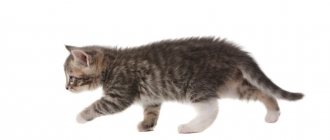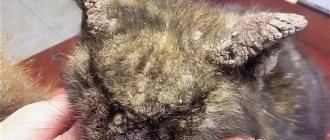During the day, adult cats visit the toilet approximately 2-3 times to urinate. This process takes no more than a minute without any signs of discomfort. Neutered cats do this more often – up to 5 times a day. As the pathology develops, more frequent visits to the litter box and the appearance of blood clots in the urine may occur.
If a cat pees with scarlet blood, this is an alarming sign that indicates the development of serious inflammatory processes and requires urgent treatment. Let's find out why blood appears in a cat's urine and how to help the animal at home.
Main causes of hematuria (blood in urine) in cats
Today, most domestic cats relieve themselves in a special litter box that masks the smell and color of urine (not to mention automatic devices that flush everything down the drain). Therefore, cat owners are not always able to notice dark brown blood flakes on the surface of the litter.
If suspicions arise (the cat behaves strangely - meows when it pees, often sits near the tray), it is worth observing the color and consistency of its urine. Normally, healthy cats' urine is transparent and has a yellow color of varying degrees of saturation. The volume of urine production is 200 ml per day.
If the cat begins to urinate with blood, or there are clots of cloudy mucus or sand in its urine, this is a consequence of the acute phase of the disease. The appearance of blood in the urine is called hematuria.
The reasons for its occurrence in domestic cats and cats are as follows:
- injury to an animal (being hit by a car, being hit, falling from high fences, being attacked by dogs);
- development of cystitis (inflammatory processes in the bladder);
- kidney diseases;
- bleeding of tumors in the urinary organs;
- urolithiasis disease;
- diseases of the genital tract (inflammation of the vagina in cats and prostate inflammation in cats);
- complications in the postoperative period (suture dehiscence);
- heart failure;
- liver diseases;
- parasites in the kidneys (dirofilaria);
- blood in the urine of females in the postpartum period.
Important! Due to the anatomical features of the structure (excretory ducts in cats are straight and shorter than in males), females suffer from urinary problems 6 times less often. Also, due to more developed cleanliness, it is very difficult to notice that a cat is urinating blood.
In what cases is red urine not a pathology?
When a natural-fed cat's diet includes beets or red carrots, the urine will inevitably turn reddish.
Also, a change in the color of urine with a red or pink tint is possible when taking medications or vitamins or colored treats. Therefore, do not panic - there is no blood in such urine, so the cat will not require treatment.
What does the urine of a healthy kitten/healthy cat look like?
Urine itself is a liquid that is formed in the kidneys and excreted through the urinary system. Thanks to this activity, harmful substances obtained from the product are removed from the pet’s body. In general, metabolic products break down food and liquids, from which salts, enzymes, hormones, vitamins and various other substances are obtained.
If we talk about shade, then urine has a transparent, yellowish or orangeish color. What makes it this color is considered to be metabolism, food, as well as the health status of the pet.
Associated symptoms
In cases where a cat actually pees with blood, accompanying symptoms appear:
- during urination the animal screams (as a result of pain);
- nervousness appears (the cat often twitches the tip of its tail or fur along the spine, and shows aggressiveness as a result of discomfort);
- leaves marks on carpets and furniture (small puddles and wet spots appear when a cat develops urinary incontinence);
- decreased appetite or lack thereof;
- a slight increase in body temperature (the norm for healthy cats is 38-39.5 degrees);
- reducing the cat’s physical activity, choosing warm places to sleep (battery, heater).
The appearance of these signs indicates an increase in the inflammatory process in the animal’s body. In such cases, the cat requires urgent veterinary care.
Dangerous diseases
There are situations when bleeding indicates serious illness. This symptom should not be ignored, as it can manifest itself under the influence of the following circumstances:
- The process of decomposition of the placenta. After giving birth, a cat's bloody discharge, which has a liquid consistency, indicates that the remains of the placenta have not left the animal's body. Most likely, the pet will require surgical intervention.
- Infectious processes occurring in the genitals. Thick light red discharge often occurs in females with pathologies of the urinary system and uterus.
- Malignant neoplasms. The leakage of blood and pus is a characteristic sign of cancerous tumors of the reproductive system. As a rule, with this pathology, the discharge has an unpleasant odor.
- Inflammatory processes occurring in the genitals, for example, in the vagina. Such diseases are accompanied by difficulty urinating, aggression and anxiety. The cat often licks the lower part of its body. This symptom indicates that the animal is feeling severe discomfort.
Which animals are at risk?
A predisposition to hematuria and frequent diseases of the urinary system appears in cats after castration, and in cats after ovariohysterectomy (removal of the uterus and ovaries). The risk group also includes animals with a monotonous diet.
These cats are at high risk of developing urolithiasis due to altered metabolism from surgery, low motility, and concentrated urine.
Crystals (struvite or oxalates) form in cat urine. They gradually increase in size and transform into conglomerates that damage the walls of the organs of the urinary system. All this leads to the cat starting to pee in blood.
Important! To prevent the development of the disease, it is recommended to take the cat’s urine for analysis once every six months (to detect crystals or inflammation) and feed the animal with a specialized preventive food of good quality.
Discharge from endometritis
This disease can have both an acute and chronic course. The second form of the disease does not affect the pet’s well-being. The cat mates with males, but in most cases pregnancy does not occur. If fertilization does occur, the cubs often die in the womb or almost immediately after birth. An acute inflammatory process in the inner mucous membrane of the uterus is a serious illness. Bloody discharge in cats with this pathology is accompanied by loss of appetite and general weakness. If you do not provide medical assistance to the animal in time, it may die.
Methods for diagnosing diseases if a cat pees blood
There are several ways to diagnose feline diseases with pronounced hematuria. All of them are carried out in a veterinary clinic after a complete examination of the animal and collection of an anamnesis (history of the disease).
Diagnostic methods:
| Way | What biomaterial is needed | What determines |
| General urine analysis | Fresh cat urine | Presence of blood cells, mucus, crystals |
| Bacteriological inoculation on a nutrient medium | Fresh cat urine | Type of infection and sensitivity to antibiotics |
| Blood chemistry | Deoxygenated blood | Kidney performance |
| X-ray examination of the abdominal cavity | Cat | Presence of stones, mineral deposits in the kidneys or bladder |
| Study with contrast agent | Cat | Stones, pathological formations, protrusions of the bladder walls |
| Ultrasound examination of the kidneys | Cat | Stones, kidney tumors |
| Histology of neoplasms in the urinary system | Particles of neoplasm | Type of tumor to prescribe treatment |
| Cystoscopy of the urethra and bladder | Cat in a state of sedation | Condition of the internal walls of organs |
It is impossible to determine at home the reason why a cat is urinating blood. The owner of the animal should urgently collect urine and deliver it to a veterinary laboratory for analysis (after examining the cat by a doctor).
How to properly collect urine for analysis
There are three proven methods:
- Using a urine collection kit. It can be purchased at most pet stores. The set consists of transparent plastic balls that do not absorb liquid and a pipette. Pour the balls into an empty, clean tray (washed with boiling water) and wait until the cat pees in it. Then tilt the tray and use a pipette to collect the urine into a sterile jar. This method is convenient for cats peeing in the litter.
- Using a tray with a grid, which can be pre-sprayed with a product to attract the cat to the toilet. Wait until the kitten goes into the tray in a small way, remove the grate and pour the urine into a jar.
- Using a urethral catheter. The method is used for urgent diagnosis in a clinical setting. This procedure should not be carried out at home, as it will require sedation (drug-induced relaxation and removal of sensitivity), as well as restraining the cat.
Important point! It is better to collect urine in the morning, before feeding the cat. It is necessary to deliver the collected material to the laboratory within 4 hours. Otherwise, the results may be unreliable and a new analysis will be required. It is advisable to indicate the time of collection of biomaterial.
If a cat cannot urinate on its own for several days, then the clinic must be told about this. Then the veterinarian will insert a catheter into the animal and forcefully empty the bladder.
Symptoms appear after sterilization
Typically, such an operation assumes the absence of estrus. However, spotting and sexual activity in a sterilized cat are sometimes observed, which indicates the following conditions:
- Neoplasms in the adrenal or mammary glands.
- The presence of cysts in the uterine area.
- Gradual cessation of hormone activity. These substances may remain in the animal’s blood for some time after surgery. As a rule, after 8 weeks this period ends.
- The presence of gonadal tissue cells in other organs.
Treatment
Treatment of cats is carried out only after diagnosis and depends on the identified pathology:
- For bacterial infections, antibiotics (in injections and tablets) with hemostatic drugs are prescribed.
- For urolithiasis - a long course of nutritional therapy and symptomatic therapy (hemostatic and antimicrobial drugs, medications to destroy crystals).
- If a cat has large stones, surgical removal is required.
- If a tumor is found, then after determining its malignancy, surgery and subsequent chemotherapy are prescribed.
- If the urinary ducts are obstructed (blockage with stones), a catheter is inserted and the bladder is washed.
- Parasitic diseases (dirofilariasis) must be treated for a long time (about 1 year) using drugs based on moxidectin.
- Injured cats are treated as inpatients; the choice of medications is determined based on the severity of the patient’s condition.
- Castrated cats with urolithiasis and hematuria are often prescribed urethrostomy - a surgical operation to create a new enlarged urethral opening, this allows the animal to pee painlessly.
If the owner notices blood in the cat’s urine, but there is no opportunity to visit a veterinarian in the near future, you need to provide first aid yourself.
What to do:
- ensure that the cat stays warm and does not let it go outside;
- make sure there is warm water in the drinking bowl;
- feed soft food or pates;
- drink a decoction of horsetail, bearberry, woolly erva (will relieve inflammation) or buy ready-made “KotErwin”;
- if urination is severely painful, you can give your cat 1 tablet of Furagin (as a result, the urine will turn a rich yellow or orange color).
This treatment can slightly improve the pet’s condition and relieve pain for a while.
Symptom during pregnancy and after childbirth
Excessive bleeding in cats during pregnancy, which is bright red or light in color and lasts more than 10 minutes, indicates damage to the uterus. In this case, you need to contact a specialist as soon as possible. Also, the appearance of brown liquid at 8-9 weeks of gestation should not be ignored.
The animal should be shown to a doctor. Laboratory tests are performed at the clinic. The veterinarian performs an ultrasound examination for the presence of dead fetuses and makes a decision about therapy.
Such a phenomenon does not always mean the presence of pathology. For example, after fertilization, you may notice pink fluid flowing from the animal's genital tract. Before the birth process begins, the discharge of dark blood is also considered quite normal. This symptom cannot be ignored when the kittens have already been born.
In this situation, it may indicate mechanical damage to the uterine tissue. Injuries often occur during the delivery process. To eliminate this problem, drugs that stop bleeding are used. In severe cases, surgical intervention is necessary. Sometimes a female who has recently given birth becomes infected in her genitals as a result of violation of sanitation rules. In this case, the cat experiences bleeding and pus. To prevent infection, it is important to keep the area where the mother and her babies are kept clean.
Prevention
The best way to prevent hematuria is high-quality feeding of the cat (premium dry food or a varied natural diet with a high level of protein), as well as comfortable living conditions (without the risk of falls from a height, injuries, transportation in hard carriers, walks in a fenced area).
Older cats (over 10 years old) must be periodically taken to a veterinarian for examination and have their blood and urine tested in order to identify illnesses in the early stages.
Animals whose owners have spayed or neutered need therapeutic nutrition, especially if they are prone to urolithiasis. The brand and abbreviation of cat food is determined by the attending physician based on test results.
Blood in a cat's urine is an alarming sign, but it is not dangerous if there is little of it. The main thing that a cat owner with such a problem should know is that they should not delay visiting a doctor, as the risk of developing anemia increases, and the pet’s suffering intensifies every day.











